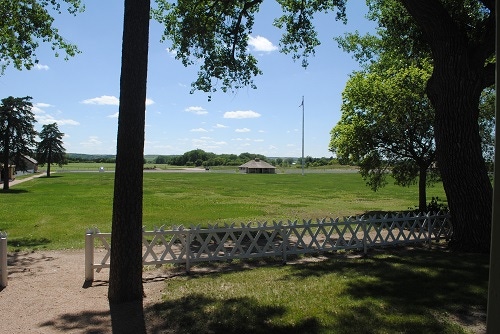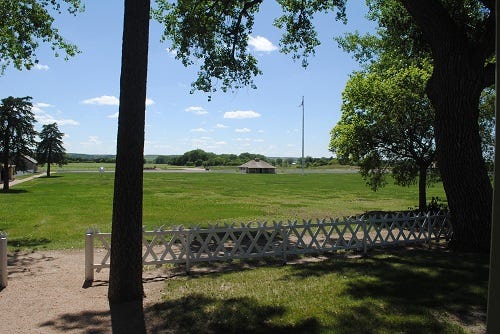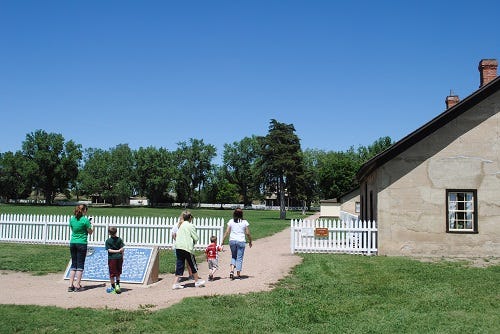
I stopped by Fort Hartsuff State Historical Park near Elyria recently, while traveling in the area for farmer interviews and future articles. I’ve been fortunate enough to visit this little hidden gem many times over the years, and each time I am amazed at how well-kept this Plains fort is and how much of the region’s history is tied up there.

Built in 1874 as a predecessor to Camp Ruggles, the fort on the Loup River was named for Major General George L. Hartsuff, a hero of both the Seminole Indian War in Florida and the Civil War. Because of an increase in settlement of the area after the Civil War, confrontations between Indians (mostly Teton Sioux) and settlers in the North Loup River valley were on the rise. So, the fort was established not only to protect white settlers from raids, but also friendly Pawnee Indians as well. Nine major buildings were constructed on the site, built of a unique lime/concrete mixture, making use of ample supplies of gravel available in the area. To emphasize the importance of this outpost, soldiers went on an expedition all the way to the Niobrara River valley to procure a 97-foot pine tree that was hauled back to the fort for use as a flagpole.

During seven years of active duty, the fort was garrisoned by a small band of around 55 men, and served as a rallying point for Loup River valley settlers. During the drought of 1873-75, local farmers and ranchers and a team of horses could earn as much as $3 a day, providing important income when crops and pastures had failed. Duty at Hartsuff was considered pleasant, with dances, 4th of July celebrations and other festive events being hosted for local settlers at the fort. It was, no doubt, an important hub for the local economy in the 1870s, and the fort served a purpose in providing a gathering place and entertainment opportunities for the settlers.
Most of the time, soldiers stationed at Hartsuff kept busy scouting the Loup and Cedar rivers for hostile Sioux, but they traveled as far north as the Niobrara River, and also helped local settlers and civil authorities hunt down horse thieves, murderers and robbers. In the spring of 1876, a detachment from Company A, 23rd Infantry, were sent out from the fort to engage a band of hostile warriors that had been harassing settlers northwest of present-day Burwell. Known as the Battle of the Blowout, three soldiers in the skirmish were awarded Medals of Honor. Sgt. William Dougherty was killed.
As the incidences of conflict decreased into the early 1880s, there was less need for the protection Fort Hartsuff provided to local settlers, so the fort was abandoned in 1881, and the buildings were sold to Union Pacific Railroad.

When a railroad on the north side of the Loup River failed to materialize, the fort grounds and buildings were sold into private hands. In 1961, Dr. Glen Auble of Ord presented the site to the State of Nebraska and the Nebraska Game and Parks Commission for preservation and interpretation of the fort’s role in the settlement of the region as a state historical park.
RELATED
All nine of the fort’s major buildings, including post headquarters, officers’ quarters, barracks, hospital, stable and guardhouse, are preserved and open to the public. Entry to the fort requires a Nebraska State Park permit and a small admission fee, but this little gem on the Loup River is a must-see in my opinion for anyone who is interested in the agriculture and cultural history of our state. There is plenty of room for the kids to roam around the gigantic parade grounds, and the fort itself provides an interesting glimpse into what it was like for soldiers and rural settlers alike to live on the Plains in the 1870s.
Here is this week's discussion question. What forts have you visited in your own region and what roles did those historic forts play for local settlers at the time? You can share your thoughts and observations here. You can learn more about Nebraska agriculture history and current farm news at Nebraska Farmer online. Be sure to follow us on Twitter at Husker Home Place.
P.S. Pilger Area Residents, Farms Hit Hard by Tornadoes
Our thoughts and prayers go out to the good folks around Pilger and surrounding communities hit so hard by the devastating tornadoes yesterday. The damage there is almost unimagineable, and the losses of human life, of homes and farms and livestock, of businesses and whole sections of the community and neighborhoods are just horrible. Here are a few links to information that folks might find useful as the cleanup and healing begins.
TORNADO AFTERMATH INFORMATION
Pilger, rural area hit hard by tornadoes - Norfolk Daily News
How to Help Those Devastated by Pilger, Nebraska Tornadoes - The Weather Channel
Nebraska's Deadly Twin Tornadoes Devastate Pilger, Stanton - NBC News
About the Author(s)
You May Also Like






